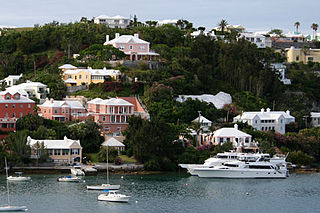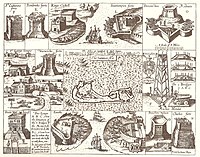
Bermuda was first documented by a European in 1503 by Spanish explorer Juan de Bermúdez. In 1609, the English Virginia Company, which had established Jamestown in Virginia two years earlier, permanently settled Bermuda in the aftermath of a hurricane, when the crew and passengers of Sea Venture steered the ship onto the surrounding reef to prevent it from sinking, then landed ashore. Bermuda's first capital, St. George's, was established in 1612.

Bermuda is the oldest British Overseas Territory, and the oldest self-governing British Overseas Territory, and has a great degree of internal autonomy through authority and roles of governance delegated to it by the national Government. Its parliament held its first session in 1620, making it the third-oldest continuous parliament in the world. As part of the British realm, King Charles III is head of state and is represented in Bermuda by a Governor, whom he appoints on the advice of the British Government. The Governor has special responsibilities in four areas: external affairs, defence, internal security, and policing.

St. George's, located on the island and within the parish of the same names, settled in 1612, is the first permanent English settlement on the islands of Bermuda. It is often described as the third permanent British settlement in the Americas, after Jamestown, Virginia (1607), and Cupids, Newfoundland (1610), and the oldest continuously-inhabited British town in the New World, since the other two settlements were seasonal for a number of years.

Castle Harbour is a large natural harbour in Bermuda. It is located between the northeastern end of the main island and St. David's Island. Originally called Southampton Port, it was renamed as a result of its heavy fortification in the early decades of the Seventeenth century.
Captain William Sayle was a prominent English landholder who was Governor of Bermuda in 1643 and again in 1658. As an Independent in religion and politics, and an adherent of Oliver Cromwell, he was dissatisfied with life in Bermuda, and so founded the company of the Eleutheran Adventurers who became the first settlers of the Bahamas between 1646 and 1648. He later became the first governor of colonial South Carolina from 1670 to 1671.

The governor of Bermuda is the representative of the British monarch in the British overseas territory of Bermuda.

The House of Assembly is the lower house of the Parliament of the British Overseas Territory of Bermuda. The house has 36 Members of Parliament (MPs), elected for a term of five years in single seat constituencies using first-past-the-post voting. Bermuda now has universal voting with a voting age of 18 years. Voting is non-compulsory. The presiding officer of the House is called the Speaker.

Bermuda has organised several different forms of militia between the 1612 and 1815. The roles of the militias included defence of the colony in complement with the activities of the British Army and Royal Navy.

Between 1612 and 1687, Bermuda had a series of militias under the Virginia Company, the Somers Isles Company, and the British Crown. In 1687, the first Militia Act was enacted.
With the start of the American War of 1812, an Act of 1813 re-organized the Military of Bermuda's nine-company regiment of foot into two battalions. The total strength of the local militia was, by then, nominally 450 men, but, as always, this was, at any moment, effectively reduced by half due to the seafaring occupations of the better part of the colony's men. Evidently, the militia no longer included any of the colony's black population, whether free or enslaved, as Lt. Colonel Francis Gore, on assuming the governorship, felt it advisable to boost the militia's strength by raising a colored corps, though this was not, in fact, done.
The Somers Isles Company was formed in 1615 to operate the English colony of the Somers Isles, also known as Bermuda, as a commercial venture. It held a royal charter for Bermuda until 1684, when it was dissolved, and the Crown assumed responsibility for the administration of Bermuda as a royal colony.

The architecture of Bermuda has developed over the past four centuries. The archipelago's isolation, environment, climate, and scarce resources have been key driving points, though inspiration from Europe, the Caribbean and the Americas is evident. Distinctive elements appeared with initial settlement in the early 17th century, and by the second half of that century features that remain common today began to appear.
Nathaniel Butler was an English privateer who later served as the colonial governor of Bermuda during the early 17th century. He had built many structures still seen in Bermuda today including many of the island's coastal fortresses and the State House, in St. George's, the oldest surviving English settlement in the New World. He also has the distinction of introducing the potato, the first seen in North America, to the early English colonists of Jamestown, Virginia.

Several of the islands strung across the South entrance of Castle Harbour, Bermuda were fortified in the early days of the territory, hence the harbour's name. When official settlement of the archipelago by England began in 1612 the first permanent town, St. George's was placed on the North side of St. George's Harbour. St. George's Harbour could be accessed directly by channels from the East. Those channels, however, were shallow, suitable, originally, only for small ships. As a consequence, and despite any major settlement on its shores, Castle Harbour was an important anchorage in the early years of the colony, with its main entrance, Castle Roads being an important route in from the open Atlantic for shipping. It was also a weak point, as it was remote from the defences of St. George's Harbour, and difficult to reach. It was quickly fortified and garrisoned by a standing militia.
Between 1639 and 1651 English overseas possessions were involved in the Wars of the Three Kingdoms, a series of civil wars and wars that were fought in and between England, Scotland and in Ireland.

Their Majesties Chappell, St. Peter's Church, in St. George's, Bermuda, is the oldest surviving Anglican church in continuous use outside the British Isles. It is also reportedly the oldest continuously used Protestant church in the New World. A UNESCO World Heritage Site, St. George's Town is the oldest surviving English settlement in the New World, having been settled by the Virginia Company in 1612.

Lieutenant-Colonel George James Bruere was a British Army officer and colonial administrator who served as governor of Bermuda from 1764 until his death in 1780. Of all Bermuda's governors since 1612, his term of office was the longest. He had a difficult time during the American Revolutionary War and is thought to have died of chronic stress caused by the interplay of Bermudians and American rebels.

Fort St. Catherine, or Fort St. Catherine's, is a coastal artillery fort at the North-East tip of St. George's Island, in the Imperial fortress colony of Bermuda. Successively redeveloped, the fort was used first by Bermudian Militia and then by regular Royal Artillery units from 1612 into the 20th century. Today it houses a museum.

The Historic Town of St George and Related Fortifications is the name used by the United Nations Educational, Scientific and Cultural Organization's (UNESCO) World Heritage Committee to identify collectively as a World Heritage Site St. George's Town, founded in 1612, and a range of fortifications, batteries, and magazines built between 1612 and 1939, the last of which was removed from use in 1953.

Pink House is a historic house and art gallery at 17 Chalmers Street in Charleston, South Carolina that is one of the oldest buildings in South Carolina and is the second oldest residence in Charleston after the Col. William Rhett House.

















